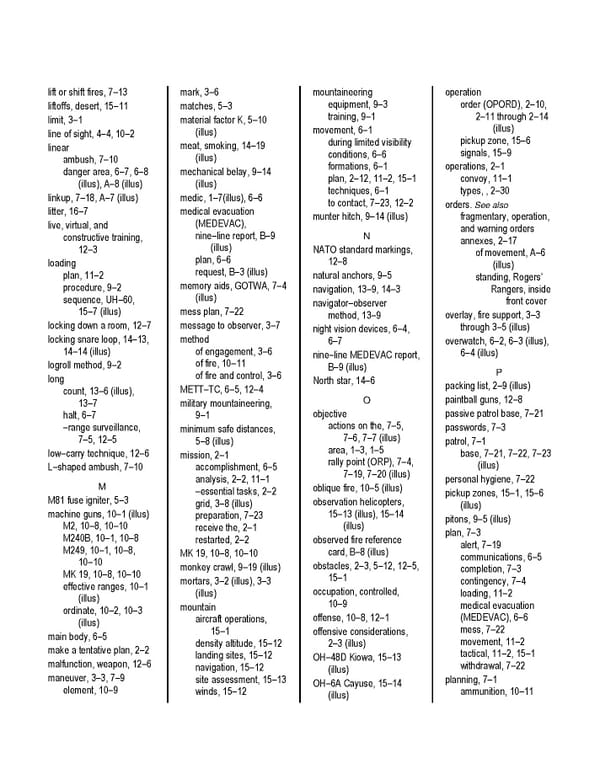lift or shift fires, 7–13 liftoffs, desert, 15–11 limit, 3–1 line of sight, 4–4, 10–2 linear ambush, 7–10 danger area, 6–7, 6–8 (illus), A–8 (illus) linkup, 7–18, A–7 (illus) litter, 16–7 live, virtual, and constructive training, 12–3 loading plan, 11–2 procedure, 9–2 sequence, UH–60, 15–7 (illus) locking down a room, 12–7 locking snare loop, 14–13, 14–14 (illus) logroll method, 9–2 long count, 13–6 (illus), 13–7 halt, 6–7 –range surveillance, 7–5, 12–5 low–carry technique, 12–6 L–shaped ambush, 7–10 M M81 fuse igniter, 5–3 machine guns, 10–1 (illus) M2, 10–8, 10–10 M240B, 10–1, 10–8 M249, 10–1, 10–8, 10–10 MK 19, 10–8, 10–10 effective ranges, 10–1 (illus) ordinate, 10–2, 10–3 (illus) main body, 6–5 make a tentative plan, 2–2 malfunction, weapon, 12–6 maneuver, 3–3, 7–9 element, 10–9 mark, 3–6 matches, 5–3 material factor K, 5–10 (illus) meat, smoking, 14–19 (illus) mechanical belay, 9–14 (illus) medic, 1–7(illus), 6–6 medical evacuation (MEDEVAC), nine–line report, B–9 (illus) plan, 6–6 request, B–3 (illus) memory aids, GOTWA, 7–4 (illus) mess plan, 7–22 message to observer, 3–7 method of engagement, 3–6 of fire, 10–11 of fire and control, 3–6 METT–TC, 6–5, 12–4 military mountaineering, 9–1 minimum safe distances, 5–8 (illus) mission, 2–1 accomplishment, 6–5 analysis, 2–2, 11–1 –essential tasks, 2–2 grid, 3–8 (illus) preparation, 7–23 receive the, 2–1 restarted, 2–2 MK 19, 10–8, 10–10 monkey crawl, 9–19 (illus) mortars, 3–2 (illus), 3–3 (illus) mountain aircraft operations, 15–1 density altitude, 15–12 landing sites, 15–12 navigation, 15–12 site assessment, 15–13 winds, 15–12 mountaineering equipment, 9–3 training, 9–1 movement, 6–1 during limited visibility conditions, 6–6 formations, 6–1 plan, 2–12, 11–2, 15–1 techniques, 6–1 to contact, 7–23, 12–2 munter hitch, 9–14 (illus) N NATO standard markings, 12–8 natural anchors, 9–5 navigation, 13–9, 14–3 navigator–observer method, 13–9 night vision devices, 6–4, 6–7 nine–line MEDEVAC report, B–9 (illus) North star, 14–6 O objective actions on the, 7–5, 7–6, 7–7 (illus) area, 1–3, 1–5 rally point (ORP), 7–4, 7–19, 7–20 (illus) oblique fire, 10–5 (illus) observation helicopters, 15–13 (illus), 15–14 (illus) observed fire reference card, B–8 (illus) obstacles, 2–3, 5–12, 12–5, 15–1 occupation, controlled, 10–9 offense, 10–8, 12–1 offensive considerations, 2–3 (illus) OH–48D Kiowa, 15–13 (illus) OH–6A Cayuse, 15–14 (illus) operation order (OPORD), 2–10, 2–11 through 2–14 (illus) pickup zone, 15–6 signals, 15–9 operations, 2–1 convoy, 11–1 types, , 2–30 orders. See also fragmentary, operation, and warning orders annexes, 2–17 of movement, A–6 (illus) standing, Rogers’ Rangers, inside front cover overlay, fire support, 3–3 through 3–5 (illus) overwatch, 6–2, 6–3 (illus), 6–4 (illus) P packing list, 2–9 (illus) paintball guns, 12–8 passive patrol base, 7–21 passwords, 7–3 patrol, 7–1 base, 7–21, 7–22, 7–23 (illus) personal hygiene, 7–22 pickup zones, 15–1, 15–6 (illus) pitons, 9–5 (illus) plan, 7–3 alert, 7–19 communications, 6–5 completion, 7–3 contingency, 7–4 loading, 11–2 medical evacuation (MEDEVAC), 6–6 mess, 7–22 movement, 11–2 tactical, 11–2, 15–1 withdrawal, 7–22 planning, 7–1 ammunition, 10–11
 Ranger Handbook Page 349 Page 351
Ranger Handbook Page 349 Page 351